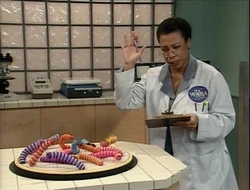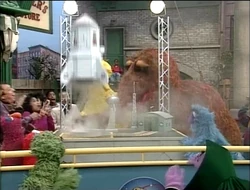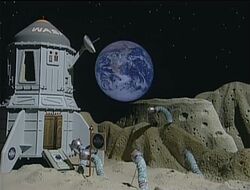No edit summary |
(2nd source for NASA advisors, trying to find more specifics about that relationship) |
||
| Line 14: | Line 14: | ||
Closer to the season premiere in November, Truglio told Kenneth M. Chanko of the ''New York Daily News'' that "there's no way to pre-test to know for sure that 2 and 3-year-olds will follow a story arc for that long a time" (since many episodes won't be about Slimey). She adds that they've included teasers to the end of episodes to help young viewers follow along. When Chanko asked "why Slimey" instead of another character, Berger explained that because Slimey can't talk, there isn't the same level of emotional investment (citing an episode where something goes wrong on the spaceship). He adds that the story also allows for Oscar to show his softer side, as he experiences separation anxiety while his pet is away.<ref>''New York Daily News'' "To the Moon, Slimey!" by Kenneth M. Chanko, Nov 16, 1997</ref> |
Closer to the season premiere in November, Truglio told Kenneth M. Chanko of the ''New York Daily News'' that "there's no way to pre-test to know for sure that 2 and 3-year-olds will follow a story arc for that long a time" (since many episodes won't be about Slimey). She adds that they've included teasers to the end of episodes to help young viewers follow along. When Chanko asked "why Slimey" instead of another character, Berger explained that because Slimey can't talk, there isn't the same level of emotional investment (citing an episode where something goes wrong on the spaceship). He adds that the story also allows for Oscar to show his softer side, as he experiences separation anxiety while his pet is away.<ref>''New York Daily News'' "To the Moon, Slimey!" by Kenneth M. Chanko, Nov 16, 1997</ref> |
||
| − | Closer still to the beginning of the first episode in the arc, Berger and executive producer [[Michael Loman]] focused less on the academic side of the series in an article for the ''Los Angeles Times'', and teased a subplot in which a chicken stows away on the ship... except no one but the farmer whose chicken it is |
+ | Closer still to the beginning of the first episode in the arc, Berger and executive producer [[Michael Loman]] focused less on the academic side of the series in an article for the ''Los Angeles Times'', and teased a subplot in which a chicken stows away on the ship... except no one but the farmer whose chicken it is.<ref>''Los Angeles Times'' "Watch out, NASA: Slimey is worming to the moon" Jan 5, 1998</ref> |
| + | |||
| + | The ''LA Times'' article also noted that a NASA advisor reviewed all the Slimey scripts; Truglio emphasized on CTW's website that they worked closely with NASA to ensure that the scripts not only satiated children's natural curiosity, but were also factually accurate.<ref>CTW.org [https://web.archive.org/web/19980502192020/http://ctw.org:80/sesame/tv/season/slimey.htm "Slimey to the Moon"] by P.J. Tanz (archived)</ref> |
||
==Story== |
==Story== |
||
Revision as of 18:40, 4 November 2018
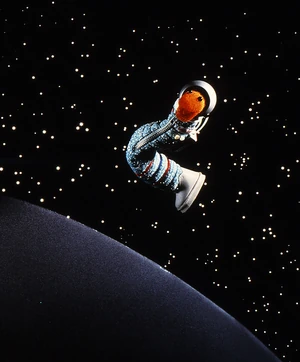
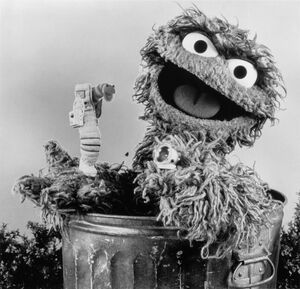

"Wish You Were Here" segment at Space Camp premiered during the moon arc.
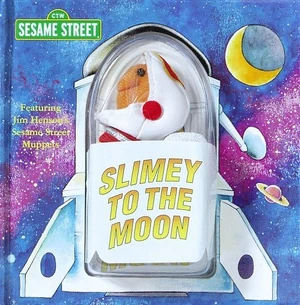
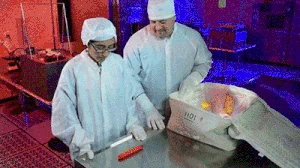
Slimey being prepared to go into actual space.
Slimey to the Moon describes a Sesame Street story arc that took place in 1998 in which Oscar the Grouch's pet worm Slimey ventured to the Moon.
Press
Although Slimey's arc didn't launch until nearly a third of the way through Season 29, a 1997 press release for the show's broadcast on PBS dubbed the season "The Science of Discovery" — the first ever science-based curriculum for preschoolers. The announcement further explained that the 18-week story line would "encourage preschoolers' natural sense of curiosity and exploration while teaching them about the wonders of science and space."
CTW also held a press conference with Oscar and Slimey on July 10, months ahead of the season premiere — timed one week after NASA landed the Pathfinder rover on Mars and the same weekend Carl Sagan's Contact was released in theatres (many newspapers covered the stories together in their science sections). While Oscar and Slimey posed for pictures, research director Rosemarie Truglio noted, "we know that children are fascinated and they're eager to learn more about space travel" and placed an emphasis on the series' lessons on conflict resolution, problem solving, persistence, and listening. Head writer Lou Berger explained that the scripts would "blend a sense of wonder and silliness".[1]
Closer to the season premiere in November, Truglio told Kenneth M. Chanko of the New York Daily News that "there's no way to pre-test to know for sure that 2 and 3-year-olds will follow a story arc for that long a time" (since many episodes won't be about Slimey). She adds that they've included teasers to the end of episodes to help young viewers follow along. When Chanko asked "why Slimey" instead of another character, Berger explained that because Slimey can't talk, there isn't the same level of emotional investment (citing an episode where something goes wrong on the spaceship). He adds that the story also allows for Oscar to show his softer side, as he experiences separation anxiety while his pet is away.[2]
Closer still to the beginning of the first episode in the arc, Berger and executive producer Michael Loman focused less on the academic side of the series in an article for the Los Angeles Times, and teased a subplot in which a chicken stows away on the ship... except no one but the farmer whose chicken it is.[3]
The LA Times article also noted that a NASA advisor reviewed all the Slimey scripts; Truglio emphasized on CTW's website that they worked closely with NASA to ensure that the scripts not only satiated children's natural curiosity, but were also factually accurate.[4]
Story
Sesame Street had previously featured space travel as a theme on a number of occasions, including multiple guest appearances by American astronaut Sally Ride. In fact, Season 29 wasn't the first time Slimey had shown aspirations for reaching the moon. Sixteen years prior, in Episode 1713, Oscar helped his pet worm launch a tiny rocket from his trash can, but after two attempts, he only made it as far as his neighbor's windowsills (the episode ends with the implication that they'll keep trying to get closer). Oscar himself made it as far as low-Earth-orbit in Episode 1714, and several other characters have imagined themselves on the lunar surface.
At least a dozen episodes dedicate themselves entirely to the moon story, while several others throughout the season made references to Slimey's journey. One recurring segment, Worms in Space, features Slimey's WASA crew mates on their ship the Wiggleprise forming letters and numbers with their bodies in zero gravity. Tony Bennett appears to sing "Slimey to the Moon" which is repeated twice, the space-themed songs "Planets, Moon and Stars" and "Moonshine" appear, and two "Wish You Were Here" segments were filmed at NASA's Kennedy Space Center and Space Camp with Miles and Gaby.
Aftermath
Outside of the episodic narrative, Slimey's star-flung exploits were featured in the book Slimey to the Moon consisting of Slimey as a finger puppet popping through each page of the book, and a coloring book called Slimey in Space which included several other Sesame Street characters embarking on space travel.
Another 16 years later, Slimey went to space for real. In 2014, NASA tested its Orion Multi-Purpose Crew Vehicle as a replacement for the Space Shuttle program. In an effort to engage public interest — and to help contribute to the weight needed to simulate a human crew and their supplies — several pop culture items were carried by the vehicle into space. Among them was a Slimey puppet which was returned to Sesame Street by astronaut Ricky Arnold.
Episodes
| Picture | Description |
|---|---|
| Episode 3696 Slimey has been expressing his interest to go to the moon for some time, having read stacks of books on the subject. He's invited to become a candidate for WASA's space program, and prepares for a visit to their headquarters. | |
| Episode 3697 At WASA's testing facility, Oscar observes while Slimey and several other worms are examined to see who has what it takes to be a worm astronaut. After he makes the cut, he returns to Sesame Street where his neighbors congratulate him and reflect on their own inspirations related to space. | |
| Episode 3698 WASA holds their launch event on Sesame Street. Slimey's friends and family wish him a safe journey, and Snuffy helps the rocket achieve lift-off with a snuffle-sized sneeze. | |
| Episode 3701 Slimey's launch into space inspires a club of pretend astronauts who call themselves the "Spaceketeers". Their activities include shaking like a rocket, practicing to walk on the moon, and counting down. At night, everyone gathers on the roof top to view Slimey's ship through a telescope. | |
| Episode 3713 An alarm sounds at the WASA monitoring station indicating that there's a problem with the mission, but it turns out the worms are just naught for cooperation. Their arguing leads to a malfunction that can only be corrected from outside the vehicle, but Oscar helps the worm astronauts through their crisis via radio headset. | |
| Episode 3719 Oscar keeps a journal of Slimey's journey to the moon, and his neighbors to everything to keep him and Slimey's family in high spirits while they wait for the worms to reach their destination. From mission control, everyone on Sesame Street gets to talk to the Wiggleprise crew via satellite video. | |
| Episode 3729 In the weeks following Slimey's departure from the Earth, a culture of sky watching has developed on Sesame Street. Everyone prepares for the Monster Moon Watch, gazing at the stars and other celestial objects in the night sky. | |
| Episode 3731 While Gordon and Elmo focus on their own physical fitness, Oscar shares with them stories from Slimey's trip to the moon, and how some of the crew aren't fond of eating freeze-dried food. | |
| Episode 3740 Roving reporter Kermit the Frog covers the first landing of worms on the moon from WASA mission control at Sesame Street. Everyone around the world watches as Slimey steps out of the ship first; he and his fellow crew collect samples from the Moon and conduct various experiments before beginning their journey home. | |
| Episode 3758 Oscar is forlorn over Slimey's birthday falling on a day when the Wiggleprise just happens to be making its way back to Earth. To cheer him up, his neighbors try to get WASA technicians to place a special call with the birthday worm. | |
| Episode 3782 By this point, Slimey has been gone so long, that everyone on Sesame Street misses him; not just Oscar (much to his chagrin... he'd rather be alone in his misery). To keep themselves focused on Slimey's return in a few days, everyone draws pictures of him in space, which Oscar frames. | |
| Episode 3785 To celebrate the homecoming of the first worms to visit the moon, WASA holds a parade on Sesame Street where the worm capsule splashes down after re-entering Earth's atmosphere. That night, Oscar and Slimey have some quiet time to reflect on the long journey. |
See Also
Sources
- ↑ Associated Press, July 11, 1997
- ↑ New York Daily News "To the Moon, Slimey!" by Kenneth M. Chanko, Nov 16, 1997
- ↑ Los Angeles Times "Watch out, NASA: Slimey is worming to the moon" Jan 5, 1998
- ↑ CTW.org "Slimey to the Moon" by P.J. Tanz (archived)


